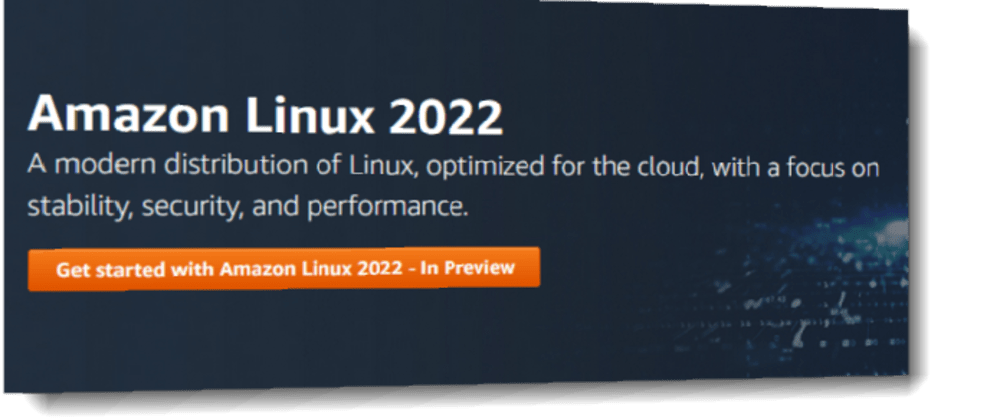Amazon Linux 2022 AMI
Amazon Linux 2022 AMI is now available. Afterall, Amazon Linux 2022, the next generation of Amazon Linux from AWS. In addition, it provides a secure, stable, and high-performance runtime environment where you can develop and run cloud and enterprise applications. Thus, with Amazon Linux 2022, you get an application environment that offers long-term support with access to the latest innovations in Linux. Above all, Amazon Linux 2022 is provided at no additional charge.
What is Amazon Linux 2022 AMI?

First of all, it is the next generation of Amazon Linux from Amazon Web Services (AWS. The objective of its design is to provide a secure, stable, and high-performance execution environment to develop and run your cloud applications. Secondly, with AL2022, every two years, a new Amazon Linux major version will be available. Each major version will be supported for five years. Amazon ECS will publish Amazon ECS-optimized AMIs to support the same 2-year release and 5-year support cycle for every new major Amazon Linux version. Hence, the two-year major release cycle helps you keep your software up-to-date while the five year support commitment for each major release gives you the stability you need to manage long project lifecycles.
Basically, every two years a new major version of Amazon Linux is released. This new version includes five years of long-term support. Each release consists of two phases. Furthermore, a standard support phase lasts two years and is followed by a maintenance phase, which lasts an additional three years. In the standard support phase, the release receives quarterly minor version updates. Therefore, during the maintenance phase, a release receives only security updates and critical bug fixes that are published as soon as they’re available.
Major and Minor Releases
Major version release— Includes new features and improvements in security and performance across the stack. The improvements might include major changes to the kernel, toolchain, glibc, OpenSSL, and any other system libraries and utilities. Major releases of Amazon Linux are based in part on the current version of the upstream Fedora Linux distribution. AWS might add or replace specific packages from other non-Fedora upstreams.
Therefore, minor version release— A quarterly update that includes security updates, bug fixes, and new features and packages. Each minor version is a cumulative list of updates that includes security and bug fixes in addition to new features and packages. These releases might include latest language runtimes, such as PHP. They might also include other popular software packages such as Ansible and Docker
Naming and Versioning
Secondly,
Thus, after every three months a minor release is provided and that is identified by an increment from 0 to N. 0 refers to the original major release for that iteration. For example, minor releases of Amazon Linux 2022 will have the following format.
2022.0.20220301
2022.1.20220601
2022.2.20220901
Version Locking
Hence, note that in the default configuration, your Amazon Linux 2022 instance doesn’t receive critical and important security updates automatically at launch.
Controlling Updates From Releases
Thus, with Amazon Linux 2022, you can ensure consistency of package versions and updates across your environment. Thus, you can ensure consistency among multiple instances from the same AMI. With the version locking feature, you can apply updates based on the schedule that works for you.
Amazon Linux 2022 locks to a specific version of your repository. This can be any major or minor version. In addition, the Amazon Linux 2022 Amazon Machine Image (AMI), exposed through our SSM parameters, is always the latest version. It has the most up-to-date packages and updates, including critical and important security updates.
Basically, no automatic support is available for launching older AMI. Therefore, any additional packages that are installed as part of provisioning map to the repository version that the older AMI was built from. You can ensure consistency among package versions and updates across your environment.
Hence, this is particularly the case if you’re launching multiple instances from the same AMI. You can apply updates based on the schedule that works for you. Basically, only specific set of updates on launch can be applied. The reason is that because these too can be locked to a specific repository version.
In the default configuration, your Amazon Linux 2022 instance doesn’t receive critical and important security updates automatically at launch.
Amazon ami 2022
Security Features
By default, Amazon Linux 2022 has SELinux enabled and is in Enforcing mode. SELinux is a security module that provides access control policies and is now the standard in the RPM based distributions such as Fedora, RHEL, and CentOS. So, locking servers is an industry wide practice to protect against malicious activity.
Therefore, AWS enforces this by default because it raises the security bar for our service. By running SELinux in Permissive mode rather than Enforcing mode, you can develop a SELinux policy for your application. We’re providing a toggle to disable the configuration if you don’t want to enforce SELinux.
Setting up Amazon Linux for use with AWS services
You can set up Amazon Linux for use with your other AWS services. For example, you can choose an Amazon Linux image when you launch an Amazon Elastic Compute Cloud (Amazon EC2) instance. You can also use Amazon Linux in a container with Amazon Elastic Container Service (Amazon ECS) or Amazon Elastic Kubernetes Service (Amazon EKS). In all of these cases, there are some prerequisites that you need to complete.
First create AWS Account
Next, simply create an IAM user
Lastly, generate and access key for the IAM user
Launching Amazon Linux 2022 using Amazon EC2 Console
Use the Amazon EC2 Console to launch Amazon Linux 2022. It is important to note that Amazon Linux 2022 does not support A1 instances. So, support is available only for instances that are based on Graviton2 or later.
To launch an Amazon Linux 2022 instance from the Amazon EC2 Console follow these instructions.
- Open EC2 Dashboard, Images, AMIs.
- Select Public images.
- Search for al2022-ami.
The list will include Amazon Linux 2022 AMIs. Make sure that amazon appears in the Owner alias
column. - Select an image from the list.
- Select Launch instance from image, and follow the instructions to complete the launch.

Using the Amazon Linux container image
The Amazon Linux container image contains same software components that are essentially included in the Amazon Linux AMI in the first place. It’s available for use in any environment as a base image for Docker workloads. If you’re using the Amazon Linux AMI for applications in Amazon Elastic Compute Cloud (Amazon EC2), you can containerize your applications with the Amazon Linux container image




